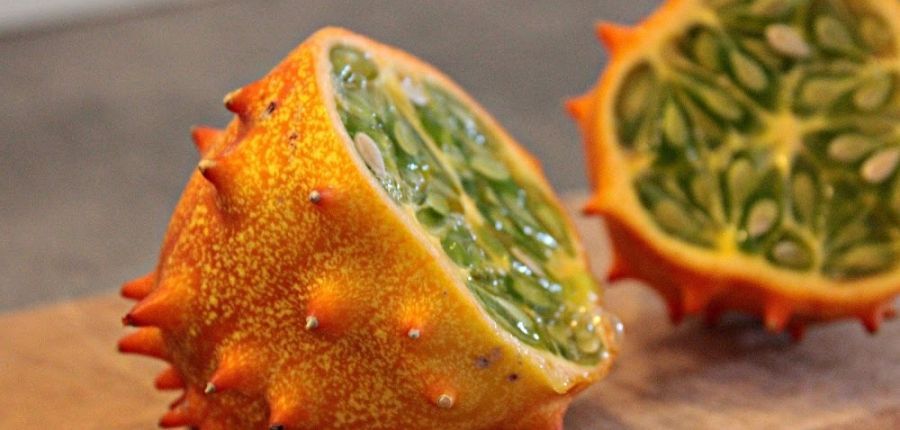How many times have you seen this strange green fruit and wondered what in the world is that? The horned melon, or kiwano, looks like an alien dinosaur egg, or perhaps some kind of scary animal horn. Despite its appearance, however, the kiwano fruit has many health benefits, and it can be quite delicious. Read on to find out more about this unusual fruit!
What is horned melon (kiwano)?
Horned melon is a fruit that comes from Africa. It is also known as a kiwano or African horned cucumber. The scientific name of horned melon is Cucumis metuliferus. The fruit has many health benefits and can be eaten in many different ways.
Horned melons are rich in vitamin C, potassium, vitamin A, magnesium, and lycopene. They are also high in dietary fiber, which helps keep the digestive system healthy.
Horned melons are a great source of vitamin C, which is known to help with immunity, healing wounds and maintaining healthy skin. The horned melon is also high in potassium, which can regulate blood pressure and heart rate. The fruit can also be used as an anti-inflammatory for those suffering from arthritis.
One study found that regular consumption of horned melons helped prevent breast cancer among premenopausal women. Finally, it’s also a good source of tryptophan for those looking for an alternative source of serotonin and dopamine production in their brain.
When it comes to cooking with this nutritious fruit, you should slice it up and place it on top of salads or add it to smoothies.
Horned melon nutritional facts:
According to USDA, per 100 g serving of horned melon provides:
- Energy: 44 kcal
- Calcium: 13 mg
- Protein: 1.78 g
- Carbohydrates: 7.56 g
- Iron: 1.13 mg
- Magnesium: 40 mg
- Phosphorus: 37 mg
- Potassium: 123 mg
- Sodium: 2 mg
- Copper: 0.02 mg
- Zinc: 0.48 mg
- Manganese: 0.039 mg
- Vitamin A: 147 IU
- Vitamin C: 5.3 mg
- Thiamin: 0.025 mg
- Riboflavin: 0.015 mg
- Niacin: 0.565 mg
- Pantothenic acid: 0.183 mg
- Vitamin B6: 0.063 mg
- Folate: 3 µg
- Beta carotene: 88 µg
Health benefits of horned melon (kiwano):
Horned melon, or kiwano, is a fruit that is native to Africa but now grown in many other parts of the world. The taste of this fruit is often described as having a mix of flavors such as pineapple, honeydew melon, cantaloupe, and cucumber.

You can eat the fruit raw by cutting it open lengthwise or slice it up into slices for a garnish. There are also recipes that call for removing the seeds with a spoon before eating. Eating the fruit is said to help promote good digestion because of its high water content. Horned melons are rich in vitamins A, C, E, K; potassium; and magnesium. If you plan on cooking your horned melon make sure you peel it first.
Horned melon or kiwano is a refreshing fruit that offers a wealth of health benefits. There are various ways to eat this fruit, with some of the most popular being adding it to your favorite dish or drinking it as a juice. As well as being a rich source of vitamin C and dietary fiber, the horned melon has been shown in studies to have antibacterial properties that help support immune function.
It’s even purported to promote weight loss due to its high level of pectin, which helps regulate blood sugar levels and boost metabolism.
Side effects of horned melons (kiwano):
Horned melon comes with range of health benefits. But be warned, there have been reports that eating too much can lead to diarrhea or stomach cramps. It’s advised not to eat more than one or two horns at a time, since they’re rich in both water and sugars.
How to eat horned melons?
Horned melons are a delicious, crunchy, and refreshing fruit that can be eaten as is or used in a variety of recipes. The unusual shape may be off-putting for some, but it makes cutting them up into slices or cubes much easier. They’re great for snacking on or adding to salads. You can even make smoothies with this delightfully exotic fruit!
A little goes a long way, so don’t go overboard when experimenting with your horned melon. It’s recommended to limit yourself to 1 or 2 servings per day. If you do experience any adverse effects after eating one of these fruits, consult your physician right away.
How to store horned melons (kiwano)?
Horned melons (kiwano) are seasonal items that are best eaten when they are ripe. To ripen them faster, store them in a paper bag in a dark place where they won’t be exposed to sunlight or heat sources such as stovetops, dishwashers, or refrigerators—they will be ready to eat within four days of being picked if stored this way.
They can also be placed in a loosely closed plastic bag and stored on the counter, but should not exceed room temperature. When fully ripe, their bright green exterior will have changed to yellowish-green or light brown coloration while still retaining some of its original glossiness.
Conclusion
While the horned melon may not be a fruit that you eat every day, it is worth trying out if you are looking for something new. It has numerous health benefits, as well as being low in calories and fat. You can eat it just like any other fruit or use it in recipes. To prepare it, cut off the top and scoop out the seeds with a spoon. Horned melons are typically served raw but they can also be grilled or roasted in an oven. They also make great popsicles!
SIMILAR ARTICLES:
